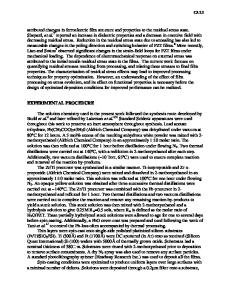Principles and Applications of Wafer Curvature Techniques for Stress Measurements in Thin Films
- PDF / 534,782 Bytes
- 11 Pages / 420.48 x 639 pts Page_size
- 59 Downloads / 364 Views
PRINCIPLES AND APPLICATIONS OF WAFER CURVATURE TECHNIQUES FOR STRESS MEASUREMENTS IN THIN FILMS PAUL A. FLINN Intel Corporation, SC9-45, 2250 Mission College Blvd, Santa Clara, CA. 95124 and Dept. of Materials Science and Engineering, Stanford University, Stanford, CA 94305.
ABSTRACT Measurement of the curvature induced in a wafer (or other flat plate) by the stress in a thin film has long been used as a convenient and accurate technique for the determination of the stress. Numerous improvements over the years have led to instruments that provide simple and rapid measurements of stress as a function of the time and temperature for any desired thermal history. A computer controlled instrument using laser scanning will be briefly described and its capabilities and limitations discussed. Applications of the technique to a variety of thin film materials will be discussed. In addition to the effects of differences in thermal expansion, stresses associated with various deposition techniques, gain or loss of material, phase transformations and flow will be considered. In aluminum based systems, themal expansion, plastic flow and phase transformation play major roles. Refractory metals show, in addition, large stresses associated with the deposition process. In inorganic dielectric systems thermal expansion effects are usually relatively small; deposition effects and the gain or loss of material are the dominant effects. Silica based glasses formed by chemical vapor deposition, for example, show large stress changes due to gain or loss of water, and plasma deposited silicon nitride films show large effects associated with hydrogen. Overall, determination of the stress as a function of time and temperature is a valuable part of the evaluation of a thin film material for use in a VLSI device.
INTRODUCTION Stress and strain in thin films have been a matter of practical importance for many years, long before 2 the era of microelectronics, in areas such as electrodeposition' and optical coatings . Many experimental techniques were developed. Some are based on direct measurement of force and displacement, esssen3 tially minaturization of traditional mechanical testing techniques . Some are indirect, such as the well known X-ray "residual stress" measurement which is actually an elastic strain mesurement from which 4 stress is inferred 5. Perhaps the most widely used class of techniques is based on measuring the curvature of a substrate produced by the stress in the film. The curvature may be measured in a variety of ways that fall into two categories: displacement measurements and direct curvature measurements. Displacement may be measured by a mechanical or elctromechanical gage, by microscopic observation, or by optical interference (fringe counting). Curvature may be measured by optical means, as will be 6 discussed in detail later, or, if a single crystal substrate is used, by an X-ray diffraction technique . Once the radius of curvature is known, the stress, a. in the film may easily be calculatedi. 7:
where E, is Young'
Data Loading...











